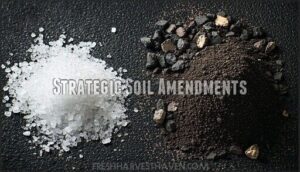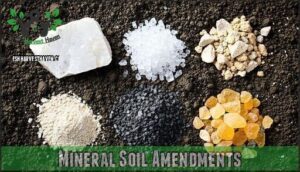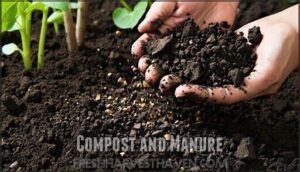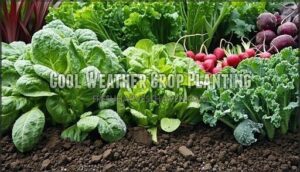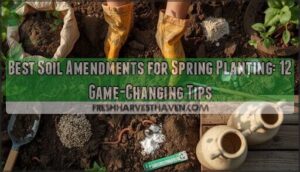This site is supported by our readers. We may earn a commission, at no cost to you, if you purchase through links.
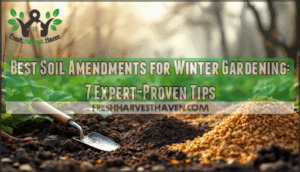
You’ll want to add compost, which feeds soil microbes even in cold weather.
Leaf mold breaks down slowly, improving drainage and structure.
Coffee grounds add nitrogen, while wood ash provides potassium for root development.
Don’t forget earthworm castings – they’re nature’s perfect fertilizer that won’t burn plants.
Cover crops like winter wheat and crimson clover fix nitrogen while protecting soil from erosion.
Think of these amendments as your soil’s winter vitamins.
Each one serves a specific purpose, and timing matters more than you might expect, making these amendments crucial for a healthy garden with proper fertilizer.
Table Of Contents
- Key Takeaways
- Winter Soil Preparation
- Soil Health Strategies
- Choosing Soil Amendments
- Natural Fertilizers
- Garden Debris Disposal
- Cool Weather Crop Planting
- Frequently Asked Questions (FAQs)
- How do I enrich my garden soil for winter?
- What is the best soil mix for winter sowing?
- What is the best fertilizer for gardens in winter?
- How do you add nitrogen to soil over winter?
- How do you amend garden soil for winter?
- What is the best soil cover for winter?
- How do you keep soil healthy in the winter?
- Can I add amendments during freezing temperatures?
- How deep should amendments be worked into soil?
- Which amendments work best for clay soil?
- Conclusion
Key Takeaways
- You’ll want to add compost and aged manure in late fall – these organic amendments feed soil microbes throughout winter and break down slowly to create nutrient-rich conditions for spring planting.
- Don’t remove healthy plant debris from your garden beds – dead stalks and leaves act as natural mulch that prevents erosion, provides habitat for beneficial insects, and kickstarts decomposition that enriches soil all winter long.
- Plant winter cover crops like clover, vetch, or winter rye – these living amendments fix nitrogen naturally, prevent soil erosion, suppress weeds, and improve soil structure while protecting your beds during harsh weather.
- Test your soil and apply mineral amendments strategically – add lime in fall for pH adjustment, wood ash for quick potassium boosts, and biochar for improved drainage, but always test first to address your garden’s specific needs.
Winter Soil Preparation
You’re probably thinking your garden’s done for the season, but winter is actually the perfect time to set up your soil for next year’s success.
Smart winter soil prep means making key decisions about plant debris, disease management, and cover crops that’ll save you tons of work come spring.
Leaving Dead Plants in Place
Those browning stalks in your garden aren’t eyesores—they’re living mulch goldmines. Dead plant matter creates natural beneficial habitats while kickstarting debris decomposition that feeds soil all winter long.
Your winter garden’s "dead" plants are actually working overtime as nature’s soil-feeding factory.
Here’s what happens when you leave plant debris in place:
- Nutrient cycling accelerates as organic matter breaks down naturally
- Erosion prevention occurs through root systems holding soil together
- Beneficial insects find shelter, creating natural pest control for spring
This garden debris acts like nature’s own compost pile, enriching your soil without extra work.
Managing Diseased Plants
While healthy plants can stay for winter protection, diseased plants need immediate removal to prevent pathogen control issues.
Quick disease identification saves your garden from spreading fungi and bacterial problems.
Your action plan for safe disposal:
- Remove infected plants immediately using clean tools
- Dispose of diseased material away from compost areas
- Practice tool sanitation between cuts to prevent cross-contamination
Proper plant removal and soil sanitization protect next season’s harvest from lingering pathogens. Gardeners should also focus on winter garden preparation to guarantee a thriving spring.
Employing Winter Cover Crops
After removing diseased plants, you’ll want to plant winter cover crops that work like soil bodyguards.
These green manures protect your garden while you’re indoors, providing nitrogen fixation and erosion control that makes spring easier.
Cover Crop Primary Benefit
Planting winter rye offers excellent weed suppression, while legumes like clover naturally fix nitrogen.
Consider sourcing seeds online for the best selection.
Cover crop types vary, but all deliver soil protection and improvement.
Soil Health Strategies
You can’t build a healthy garden without healthy soil, and winter’s the perfect time to give your dirt the TLC it needs.
Smart soil strategies now mean stronger plants and better harvests when spring arrives.
Soil Aeration and Enrichment
Breaking through winter’s frozen grip, soil aeration creates breathing room for spring’s garden comeback. Smart aeration tools like broadforks pierce compacted earth without destroying precious mycelium benefits that store moisture and nutrients. Many gardeners find essential aeration tools helpful for this task.
Your winter soil amendments strategy starts here:
- Use gentle piercing motions for effective compaction prevention
- Time compost incorporation during aeration for maximum soil enrichment
- Apply aged manure to feed beneficial microbes
- Test soil pH before adding organic amendments
This soil improvement approach transforms dense earth into thriving soil structure that welcomes roots and retains nutrients.
Soil Preparation for New Beds
Starting fresh garden beds requires thoughtful soil preparation before winter sets in.
Tilling Depth of 8-10 inches creates the foundation your plants need. Add Initial Amendments like compost, then let Soil Settling happen naturally over winter months.
| Preparation Step | Winter Benefit |
|---|---|
| Deep tilling 8-10 inches | Better root penetration |
| Compost Incorporation | Nutrient-rich garden soil |
| Natural settling period | Improved soil structure |
| Weed Control measures | Clean spring planting |
Winter Soil Improvement Techniques
After setting up new beds, winter soil improvement becomes your secret weapon for next season’s success. Freeze-thaw cycles naturally break down amendments while microbial activity slows but doesn’t stop. Snow cover benefits act like nature’s insulation, protecting your winter soil amendments investments.
Winter soil testing reveals what your garden needs most. Dormant feeding through organic matter gives soil organisms time to work their magic without plant competition. Adding compost provides essential organic matter to the soil.
Here’s your winter garden soil amendments strategy:
- Layer compost and aged manure before first frost
- Apply lime or sulfur based on soil test results
- Mulch heavily to maximize soil improvement winter benefits
Choosing Soil Amendments
You’ll want to match your soil amendments to your garden’s specific needs, just like picking the right tools for a job.
Test your soil first to identify pH levels and nutrient gaps, then choose organic options like compost for overall health or mineral amendments like lime for targeted fixes.
Strategic Soil Amendments
Soil amendments work like precision tools when you time them right. Amendment timing transforms your winter garden preparation—apply lime during fall for pH balancing, sulfur in early spring for acidic adjustments.
Soil testing reveals nutrient deficiencies before you guess what’s missing. Tailoring amendments to your garden’s needs guarantees optimal soil health and plant growth.
organic matter
Strategic soil improvement winter planning beats random amendments every time.
Organic Soil Amendments
Winter’s arrival doesn’t mean your soil’s vacation time. Organic amendments work like tiny soil architects, rebuilding your garden’s foundation from the ground up.
These natural powerhouses deliver nutrients without the harsh chemicals that can damage delicate winter ecosystems. Compost Benefits include slow-release nutrients that feed plants gradually, while Worm Castings offer gentle fertility perfect for sensitive winter roots.
Manure Types boost soil health with essential nitrogen and beneficial microorganisms. Green Manures like clover naturally fix nitrogen while shielding soil from harsh weather. Many gardeners find compost improves soil structure over time.
Here’s what makes gardeners smile about organic amendments:
- Your plants wake up stronger in spring
- Earthworms multiply like crazy (nature’s approval!)
- Water retention improves dramatically
- Soil structure becomes fluffy and workable
Mineral Soil Amendments
Mineral amendments frequently transform struggling gardens into thriving ecosystems. You’ll want to add lime application during fall to neutralize acidic soils and boost calcium levels.
Wood ash provides quick alkalinity and potassium, perfect for clay improvement. Sand amendment helps heavy soils drain better, preventing waterlogged roots.
Biochar benefits include enhanced drainage and long-term carbon storage. Gypsum breaks down compacted clay while reducing harmful sodium buildup. Sulfur use effectively lowers pH in overly alkaline conditions.
To improve soil’s overall health, consider adding organic soil amendments.
| Amendment | Primary Benefit | Application Rate |
|---|---|---|
| Lime | pH adjustment | 5-10 lbs per 1,000 sq ft |
| Gypsum | Clay breakdown | 10-15 lbs per 1,000 sq ft |
| Wood Ash | Quick alkalinity | 2-5 lbs per 1,000 sq ft |
Test your soil first, then choose amendments that address specific deficiencies for ideal results. This step is crucial for ensuring the amendments are effective in transforming your garden into a thriving ecosystem with enhanced drainage and proper pH adjustment.
Natural Fertilizers
You’ll find that natural fertilizers work like a slow-release vitamin for your winter garden, feeding soil organisms that keep working even in cold weather.
Compost, aged manure, and cover crops don’t just add nutrients—they improve soil structure and water retention, giving you healthier plants come spring, which is a result of the fertilizers acting like a vitamin.
Compost and Manure
Building healthy soil starts with nature’s best recyclers: compost and manure. These winter soil amendments pack your garden with nutrients that plants crave. Aged manure brings essential nitrogen while avoiding root burn that fresh manure causes. Compost nutrients feed beneficial microbes year-round, creating a thriving underground ecosystem.
Here’s your winter soil amendment strategy:
- Apply aged manure in late fall for slow-release nutrition through spring
- Layer finished compost 2-3 inches thick across garden beds
- Brew compost tea monthly for liquid fertilizer boosts
Manure decomposition happens slowly in cold weather, giving you steady nutrient release. You can also use eggshells for calcium to prevent deficiencies. Manure microbes work alongside compost organisms to improve soil structure. This dynamic duo transforms tired dirt into fertile growing medium that’ll reward you with healthier plants.
Green Manures and Cover Crops
Beyond compost and manure, green manures deliver powerful nitrogen fixation while you sleep.
Plant winter cover crops like clover or vetch for natural soil structure improvement and erosion control.
These living amendments provide weed suppression and create biodiversity benefits that chemical fertilizers can’t match.
| Cover Crop Type | Primary Benefit |
|---|---|
| Clover | Nitrogen fixation |
| Winter Rye | Erosion control |
| Vetch | Soil structure |
| Buckwheat | Weed suppression |
| Crimson Clover | Biodiversity benefits |
Crop Rotation and Soil Improvement
Smart gardeners know that crop rotation creates the foundation for exceptional soil improvement during winter months.
You’ll break pest cycles while enhancing nutrient cycling through strategic plant family changes each season. This approach transforms your garden’s health naturally.
Here’s why rotation benefits matter:
- Soil structure strengthens as different root systems penetrate various depths
- Pest management improves when you disrupt their breeding patterns
- Nitrogen fixation occurs when legumes prepare beds for heavy feeders
Cover cropping amplifies these rotation benefits substantially.
Garden Debris Disposal
You’ll face tough choices about what stays and what goes when cleaning up your winter garden.
Smart debris disposal protects your soil from disease while creating valuable compost that’ll boost next season’s growth.
Composting and Recycling
Your kitchen scraps and fallen leaves aren’t waste—they’re garden gold waiting to happen.
Your winter garden isn’t sleeping—it’s secretly building next season’s success story underground.
Winter composting transforms potato peels, coffee grounds, and garden debris into nutrient-rich soil amendments.
Compost activators speed decomposition in your compost bin.
Try vermicomposting benefits with worms or the bokashi method for faster results.
Brew compost tea from finished compost for liquid fertilizer.
This recycling reduces waste while building soil health naturally.
Removing Spent Plants and Weeds
Once you’ve tackled composting, it’s time for winter cleanup. Remove spent plants and tackle weed identification with sanitized tools.
Tool sanitation between cuts prevents spreading disease.
Healthy weeds can join your composting options, but diseased plants need separate plant disposal.
Smart garden debris disposal now prevents creating a pathogen playground for spring.
Preventing Disease Pathogens
Protecting your garden from becoming a pathogen playground requires swift action. Remove infected plants immediately—don’t let diseased plants overwinter and spread fungi to healthy crops.
Plant disposal tactics that work:
- Sanitize garden tools between cuts to stop cross-contamination
- Improve airflow around plants to reduce moisture buildup
- Practice crop rotation and avoid overwatering vulnerable areas
Smart prevention beats costly treatment.
Cool Weather Crop Planting
Winter gardening doesn’t mean you’re stuck waiting until spring to plant your vegetables.
Cool-season crops like spinach, kale, and radishes actually thrive in chilly weather, but they’ll need well-amended soil with good drainage to handle winter’s wet conditions and temperature swings.
Planting Cool Season Vegetables
Cool weather crops transform your winter vegetable garden into a productive powerhouse. Smart crop selection and seed starting timing create successful winter harvests despite challenging frost tolerances.
Your cool weather crop planting strategy includes:
- Start hardy vegetables like kale, spinach, and peas in fall
- Time succession planting for continuous harvests throughout winter
- Apply soil amendments for winter gardening before planting
- Focus on winter soil preparation to support root development
You’ll enjoy fresh vegetables all season long!
Using Row Covers and Mulch
Your cool-season vegetables need protection when winter’s bite arrives. Row Cover Types range from lightweight floating covers that shield plants from frost while allowing light through, to heavier fabric that blocks wind.
Winter Protection starts with proper Mulch Application Timing—apply organic mulch after the first frost to lock in soil warmth.
| Protection Method | Benefits |
|---|---|
| Floating Row Covers | Blocks frost, allows sunlight |
| Straw Mulch | Prevents weeds, retains moisture |
| Leaf Mulch | Provides soil insulation, deters pests |
| Winter Fabric | Wind protection, Temperature Regulation |
Winter mulch acts like a cozy blanket for your soil amendments, creating the perfect environment for winter soil care success.
Improving Soil Drainage and Structure
Row covers keep plants warm, but waterlogged soil kills them faster than frost. Poor soil drainage turns your winter garden into a swamp, drowning roots before they can establish.
Testing your soil’s drainage is simple—dig a 12-inch hole and fill it with water. If it doesn’t drain within 24 hours, you’ve got work to do. Amending Clay Soil requires breaking up those dense particles with organic matter like compost or aged manure. Sand Application helps, but don’t overdo it—too much creates concrete-like conditions.
- Aeration Techniques: Use a broadfork to pierce compacted areas without destroying soil structure
- Biochar Benefits: Adds permanent drainage channels while storing carbon long-term
- Organic Matter: Improves soil aggregates, creating natural water pathways
Soil compaction prevents oxygen flow, so avoid walking on wet beds.
Frequently Asked Questions (FAQs)
How do I enrich my garden soil for winter?
Add compost, aged manure, or worm castings to your garden beds this fall.
These organic amendments break down slowly over winter, feeding soil microbes and improving structure for healthier spring planting conditions.
What is the best soil mix for winter sowing?
You might think winter sowing needs special soil, but regular seed-starting mix works perfectly.
Use equal parts compost, peat moss, and vermiculite.
This combination drains well while retaining moisture for successful germination.
What is the best fertilizer for gardens in winter?
Compost stands out as winter’s best fertilizer choice.
It feeds your soil slowly without burning plants during dormancy.
You’ll also benefit from aged manure applied in late fall for spring nutrition.
How do you add nitrogen to soil over winter?
Raw manure works best when applied in late fall, giving it time to decompose safely.
You can also plant nitrogen-fixing cover crops like clover or peas to naturally boost soil nutrients throughout winter.
How do you amend garden soil for winter?
Like preparing a warm blanket for sleeping earth, you’ll enrich garden soil by mixing compost, aged manure, and lime into beds.
Test pH first, then incorporate organic matter deeply before frost arrives.
What is the best soil cover for winter?
Fallen leaves make excellent winter soil cover.
They’ll decompose slowly, feeding beneficial microbes and earthworms.
Add a 3-inch layer over your beds—it’s free mulch that protects roots and prevents weeds naturally.
How do you keep soil healthy in the winter?
Keep your soil healthy during winter by adding compost and aged manure in fall.
Avoid walking on beds to prevent compaction.
Leave beneficial plant debris as natural mulch, and test soil pH every few years, to ensure your soil remains healthy.
Can I add amendments during freezing temperatures?
Ironically, frozen ground won’t stop you from spreading dry amendments like lime or wood ash on top.
They’ll slowly work into soil as it thaws and refreezes, getting a head start on spring improvement.
How deep should amendments be worked into soil?
Work amendments into the top 8-10 inches of soil for new beds.
For established gardens, you’ll only need to incorporate them into the top 2-4 inches to avoid disturbing plant roots.
Which amendments work best for clay soil?
Like butter melting on hot toast, clay soil needs organic matter to soften its stubborn grip.
You’ll want compost, aged manure, and biochar to improve drainage and create air pockets your plants desperately need.
Conclusion
Think of winter soil preparation as planting seeds for next season’s success.
The best soil amendments for winter gardening you’ve learned about work together like a well-orchestrated symphony. Your compost feeds hungry microbes, cover crops protect against erosion, and organic matter builds structure.
Don’t wait until spring’s rush begins. Start implementing these amendments now, and you’ll discover that winter isn’t your garden’s enemy—it’s your secret weapon for creating thriving, nutrient-rich soil that’ll reward you come growing season.
- https://www.vegega.com/blogs/gardening-tips/how-to-amend-soil-for-winter
- https://livetoplant.com/the-best-seasonal-amendments-for-optimal-plant-health/
- https://www.bobvila.com/articles/improve-garden-soil-in-winter/
- https://www.journeymanhq.com/21215/exploring-different-soil-amendments-for-garden-health/
- https://savvygardening.com/garden-soil-amendments/


